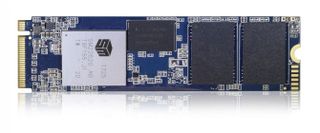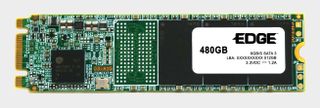Edge Memory shows off NextGen M.2 NVMe drive
It's a crowded market, but more competition never hurts.

You're forgiven if you've never heard of Edge Memory. It's a subsidiary of Avant Technology, a large supplier of memory devices though not a name that's necessarily familiar among PC enthusiasts. The focus has been on OEM products in the past, but Edge Memory is looking to go after the mainstream consumer market. To that end, the company announced several new SSDs that are slated for release in the near future.
The most interesting of the drives is the NextGen M.2 NVMe, which comes in capacities of 120GB/250GB/500GB/1TB/2TB. That covers all the bases, though I'd expect the smallest two models may suffer from reduced performance compared to the larger drives. The NextGen pairs a Silicon Motion SM2262 controller with 3D TLC NAND, and Edge claims read/write speeds of up to 3.2/1.9GB/s, with 370K/300K IOPS. We've seen other drives that use Silicon Motion controllers, including the Intel 600p (SM2260 with custom firmware). Assuming the newer version improves performance, the NextGen should be a capable drive.
The real question for most of us will come down to pricing. With the 512GB Intel 600p sitting at right around $200, right alongside the WD Black 512GB drive, and the higher performance Samsung 960 Evo 500GB priced at $230, we want either lower pricing than Intel/WD with similar or better performance, or we'd need to see better performance than the Samsung 960 Evo at a higher price. The specs look good, but Edge hasn't revealed a launch date or pricing yet.

Edge also has a new CLX600 M.2 SATA drive coming, with capacities of 60/120/240/480GB. It uses the Silicon Motion SM2258XT controller, also with 3D TLC NAND, though performance is substantially lower than the NextGen drive. The 480GB model lists maximum read/write speeds of 500/400 MB/s and 54K/59K IOPS, so pretty typical of budget SATA drives.
PC Gamer Newsletter
Sign up to get the best content of the week, and great gaming deals, as picked by the editors.
Jarred's love of computers dates back to the dark ages when his dad brought home a DOS 2.3 PC and he left his C-64 behind. He eventually built his first custom PC in 1990 with a 286 12MHz, only to discover it was already woefully outdated when Wing Commander was released a few months later. He holds a BS in Computer Science from Brigham Young University and has been working as a tech journalist since 2004, writing for AnandTech, Maximum PC, and PC Gamer. From the first S3 Virge '3D decelerators' to today's GPUs, Jarred keeps up with all the latest graphics trends and is the one to ask about game performance.
Most Popular






